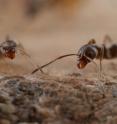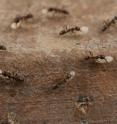New method to stop Argentine ants
RIVERSIDE, Calif. -- University of California, Riverside researchers may have found a better, more environmentally friendly way to stop the procession of Argentine ants, which have been spreading across the United States for the past few decades, despite pest control efforts. The Argentine ant is an invasive species that has become a major nuisance in California and southern states, including Georgia, South Carolina. Alabama, Mississippi, Louisiana, Florida, Tennessee and North Carolina. In fact, a 2007 survey found that 85 percent of all urban pest control services in California were focused on the Argentine ant.
A common weapon for managing the Argentine ant has been residual insecticide sprays, insecticides that remain effective for a length of time after being sprayed on a surface. However, the downside of this tactic is that the insecticides can find their way into water systems and harm some aquatic species.
Another common management technique is baiting, where the ants take food mixed with insecticides back to their colony and then expose other ants to the toxins. This method is more environmentally friendly, but it can be tricky to perfect because the baits need to be palatable, non-repellent, slow-acting, transferable, and inaccessible to non-ants.
In an effort to improve the baiting technique, a team from the UC Riverside added ant pheromones to the bait. They found that baits with pheromones reduced ant activity by 74 percent after four weeks. Baits without pheromones reduced ant activity only 42 percent after four weeks.
The researchers used the Argentine ant pheromone (Z)-9-hexadecenal, which is inexpensive enough that the researchers believe they could be an economically viable modification to existing bait products.
This result came as a bit of a surprise to the authors.
"We expected the pheromone-assisted gel bait to attract more ants, but the amount of Argentine ant control in homes was quite remarkable," said Kevin Welzel, an author of the paper and a graduate student at UC Riverside who works with Dong-Hwan Choe, an assistant professor of entomology and an assistant cooperative extension specialist.
Welzel added: "A good way to explain why the pheromone bait worked better is to think about it like the smell of your favorite food. Once you smell your favorite food, you tend to go to the source of the food and you may find it difficult to resist the temptation to consume it. Essentially, we just added an attractive smell to bait that didn't have an odor. This attractive smell allows the Argentine ants to quickly locate and then consume more of the bait."
Source: University of California - Riverside
Other sources
- New Method to Stop Argentine Antsfrom Science BlogWed, 2 Mar 2016, 17:20:44 UTC
- New method to stop Argentine antsfrom Science DailyWed, 2 Mar 2016, 3:10:41 UTC
- New method to stop Argentine antsfrom PhysorgTue, 1 Mar 2016, 21:20:31 UTC

